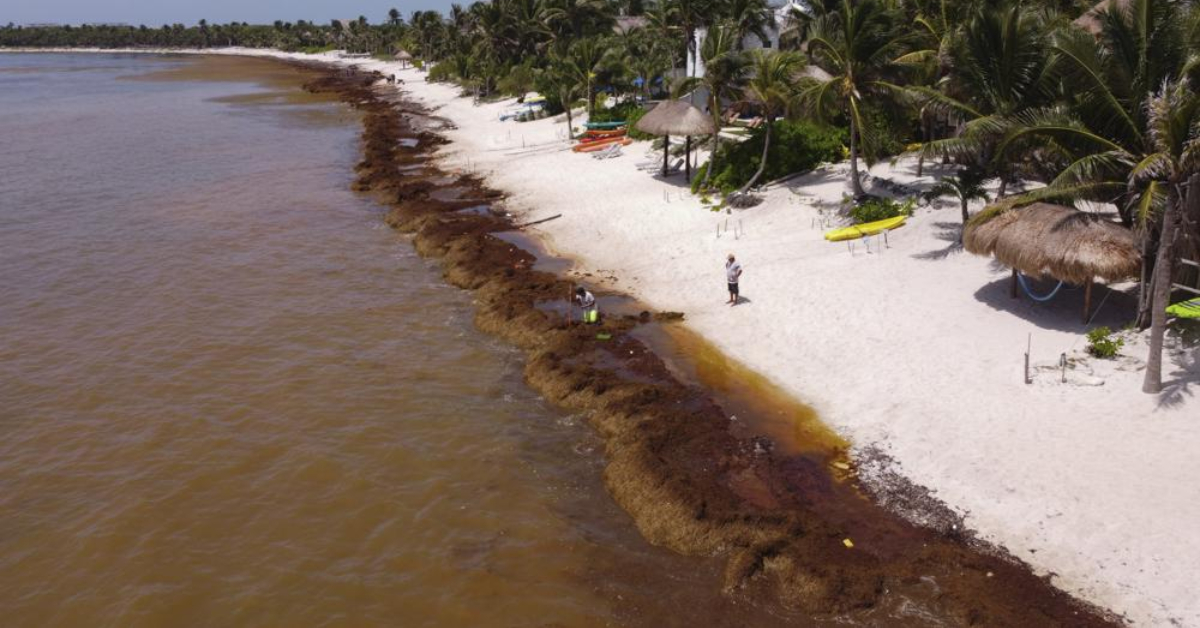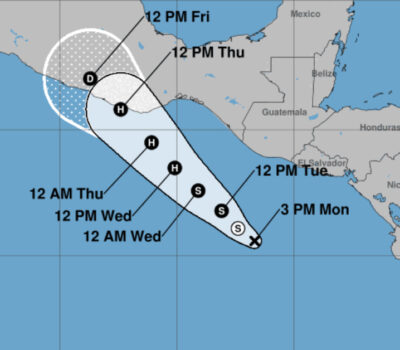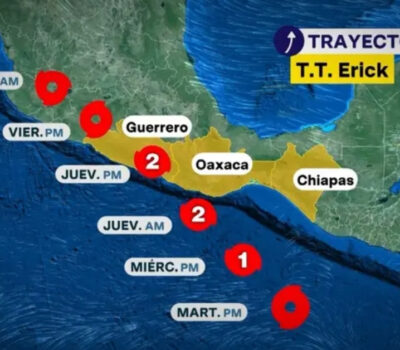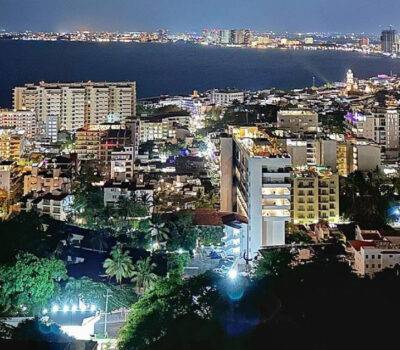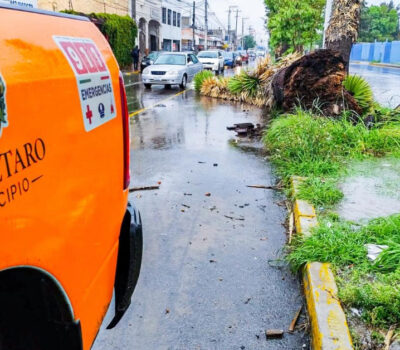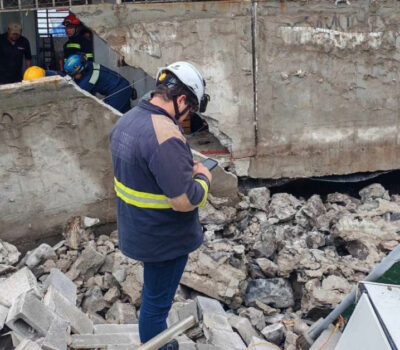TULUM, Mexico (AP) — Scraping the smelly sargassum seaweed off some beaches on Mexico’s resort-studded Caribbean coast has become not only a nightmare, but possibly a health threat, for the workers doing it — with the quantities washing ashore this year seemingly mountains not mounds.
Decomposing sargassum, which is actually algae, generates hydrogen sulfide gas. In small amounts in open areas, it’s not much more than an annoying odor: sulfurous, like rotting eggs.
But in the quantities seen in once-paradisical beach towns like Playa del Carmen, Tulum, and Xcalak, scientists say it can be dangerous to workers with respiratory problems as they rake up the seaweed maskless in the scorching heat. This year appears on track to be worse than even the peak sargassum year of 2018.
Ezequiel Martínez Lara is one of thousands of laborers who work six to eight hours per day heaving mounds of sargassum into wheelbarrows with pitchforks and then wheeling them off the beach to a growing pile on a neighboring street.
Martínez Lara used to earn as much as $50 per day guiding sports fishermen on catch-and-release outings, but now makes less than half that for collecting around 40 wheelbarrows of sargassum every day.
It is a Sisyphean task at a beach north of Tulum, where huge mats of seaweed float just offshore.
“If we clean it all off today, tomorrow more will have washed in,” said another worker, Austin Valle.
But workers like Martínez and Valle are exposing themselves to more than just the burning sun, says Rosa Rodríguez Martínez, a biologist in the beachside town of Puerto Morelos who studies reefs and coastal ecosystems for Mexico’s National Autonomous University.
“At the university we have started to measure the quantity of gases that sargassum produces when it is scraped up,” Rodríguez Martínez said. “At one spot (in a decomposed pile of seaweed) it reached 56 parts per million. That’s very high. Above two, that can be dangerous for people with respiratory problems.”
“I took off running” from the spot, she said.
Martínez Lara doesn’t have the luxury of avoiding the hydrogen sulfide gas. Like almost every other sargassum worker on the coast, he has no mask, gas sensor or medical care. He works at a day rate for the person who owns the house in front of the beach.
“When sargassum rots, it gives off a very strong odor like acid, and it is very bothersome when you breath it; it hurts a lot,” Martínez Lara said. He said he takes more simple precautions.
“We try to clean it off (the beach) as quickly as possible … to get it off when it is as fresh as possible,” he says.
A 2019 article in the Journal of Travel Medicine includes the disturbing warning, “More chronic exposure to these gasses can lead to conjunctival and neurocognitive symptoms such as memory loss and impaired balance, as well as non-specific symptoms such as headache, nausea and fatigue.”
The Florida Health Department, on the other hand, says “hydrogen sulfide levels in an area like the beach, where large amounts of air flow can dilute levels, is not expected to harm health.”
The sargassum problem isn’t as bad for tourists as for workers. But neither is it pleasant.
Ligia Collado-Vides, a marine botanist at Florida International University who specializes in studying macroalgae like sargassum, said, “If you’re swimming for a little bit, it shouldn’t be a danger at all,” but added that tiny jellyfish cousins known as hydrozoa often inhabit sargassum mats.
“If you’re going to be there for a long time playing in the sargassum, you can get like many, many, many stings from hydrozoans and those are toxic,” she noted, adding that long sleeves — something almost nobody wears at the beach — might help.
Sarah Callaway, a tourist from Denver, Colorado, was pretty much confined to playing with her kids in the pool in front of their rented beach house.
“The property is beautiful, but we were automatically struck … by the smell,” Callaway said. “The smell is really pungent and very strong. And then, yeah, we were disappointed with how much seaweed sargasso there is here.”
“The kids have tried to get in the ocean, but then they get kind of overwhelmed by it. So we really haven’t gotten to do the beach part of it, which is why we came,” she said.
It will also impact locals who depend on the tourist trade. Hundreds of thousands of people migrated to the coast in recent years for better paying jobs, but some may now be considering leaving.
Valle, the seaweed cleaner, said one of his friends in Tulum has been thinking of giving up her snack stand business because sales have dipped so much.
It’s hard to measure the impact on tourism. The Caribbean coast suffered a drop in visits during the coronavirus pandemic, but because Mexico never declared travel restrictions, testing requirements or mandatory mask rules, Americans have continued to come.
International tourism to the country as a whole surpassed pre-pandemic levels in the first half of 2022, with 10.26 million visitors from January to June, 1.5% higher than the 10.11 million tourists who arrived in Mexico in the first half of 2019.
Mexico’s strongest showing was with U.S. tourists. The number of Americans arriving by air in the first six months of 2022 was 6.66 million; that is 19.1% higher than in the same period of 2019.
But that boom may be slowing. Grupo Financiero Base noted in a research report that international tourist arrivals in June 2022 were down 13.8% from levels in June 2019. It’s unclear what — sargassum, inflation, or the war in Ukraine — may have caused that dip.
And overall tourist spending remains below pre-pandemic levels.
The picture is mixed because some of the most-heavily developed resorts like Cancun have not suffered as much from sargassum as lower-key resorts further south, like Playa del Carmen and Tulum.
Ocean currents and islands like Isla Mujeres shield Cancun from much of the floating sargassum. Given the large number of big hotels in Cancun with huge cleaning staffs and money to deploy floating booms, what sargassum does arrive is cleaned up more quickly.
The jury is still out on the floating booms, meant to trap sargassum mats at sea before they reach the beach.
“When the sea is calm, all types of booms work,” Rodríguez Martínez said. “When there are waves, none of them work.”
Some tourists like the area so much they’ll keep coming back.
“I will absolutely be back. We love it here,” said Jeff Chambers, a tourist from Palm Desert, California, who was strolling down the main seaside street in Tulum. “We like things a little slower.”
Some locals like Victor Reyes, who works in real estate in Tulum, are more sanguine about the seaweed, noting that it’s not so bad in the winter months.
“In the winter it’s better. In November, when the tourists want to come, the sargassum is gone,” Reyes says.
As bad as sargassum is for people — and Collado-Vides stresses that much more study is needed — it’s far worse for seagrass, fish and other marine life suffocated by seaweed that drops to the bottom, decomposes and creates oxygen-depleted or anoxic layers similar to dead zones.
“Sargassum stays there and goes down into the water column so nobody sees it, but on the bottom it is creating anoxic conditions,” she said.
Recounting one recent monitoring expedition, Collado-Vides said: “It’s really terrible … the amount of vertebrates, the amount of crabs, the amount of fish dead in just a 1-square meter quadrant.”
TULUM, Mexico (AP) — Scraping the smelly sargassum seaweed off some beaches on Mexico’s resort-studded Caribbean coast has become not only a nightmare . . .

